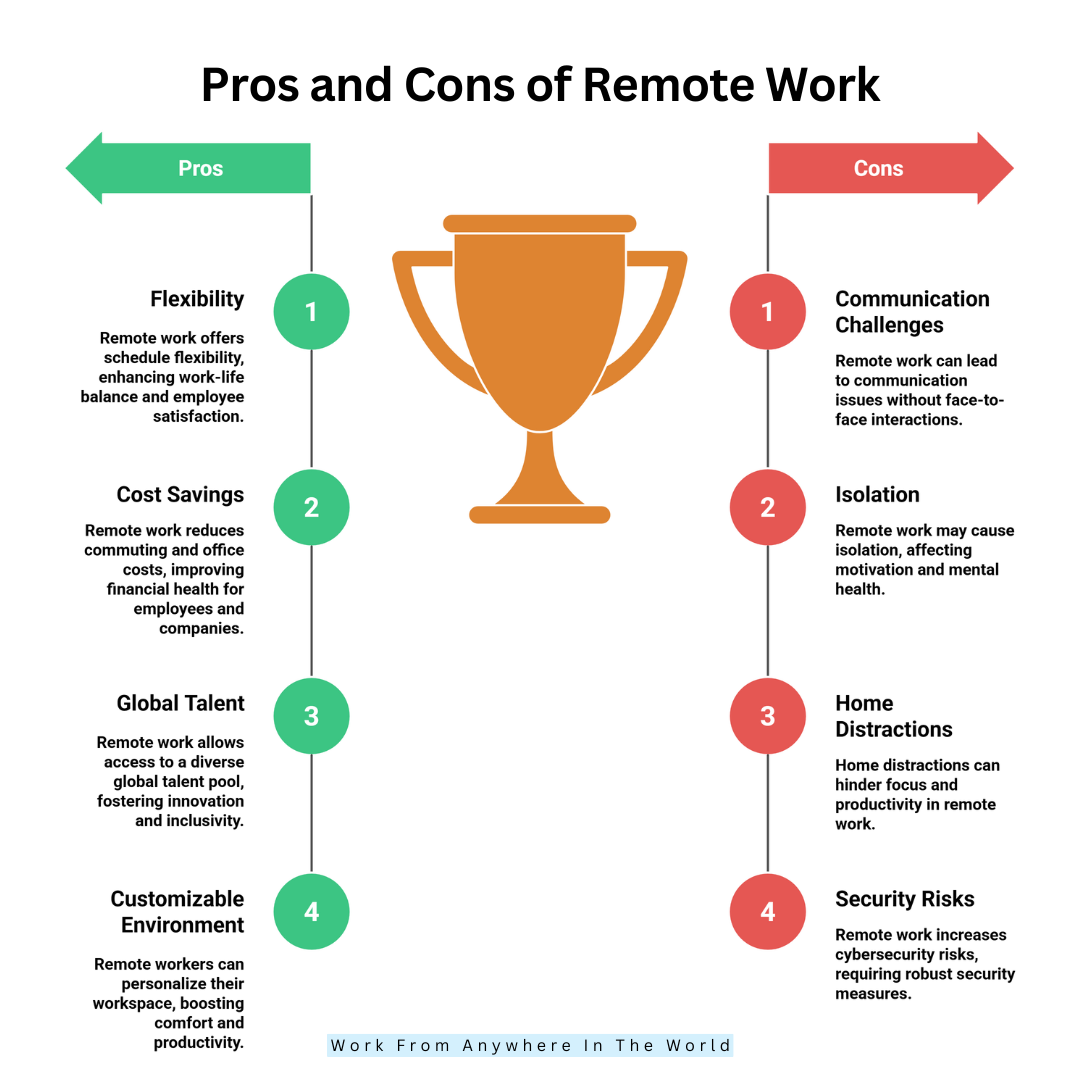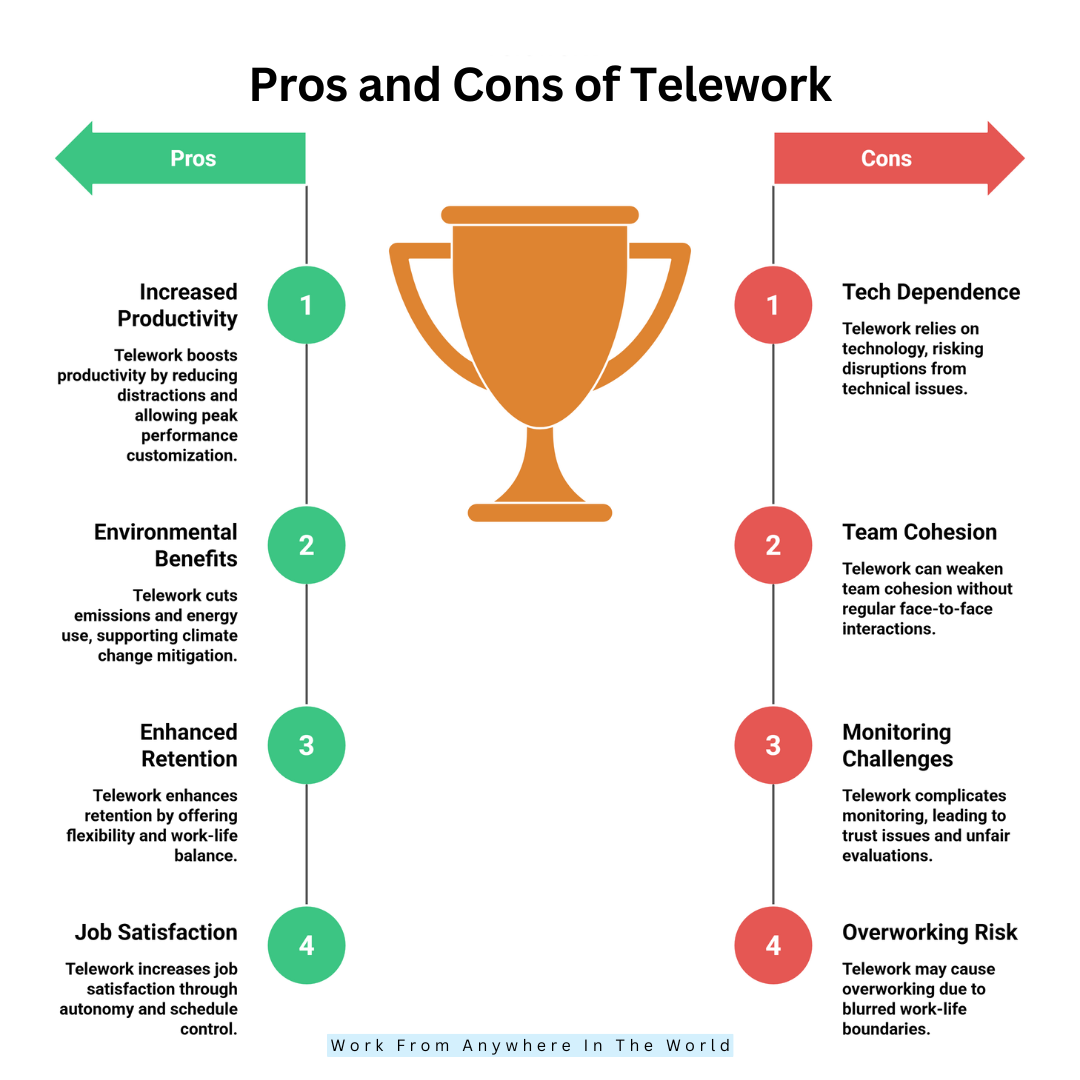Ultimate Guide To Remote Work vs Telework Success
The Ultimate Guide To Remote Work vs Telework Success
Remote Work vs Telework—what’s the real difference? In today’s flexible work environment, many people use these terms interchangeably.
Nonetheless, you can select the best solution for your business or career by being aware of their distinctive qualities.
Whether you want complete freedom or prefer a structured setup, this guide breaks down Remote Work vs Telework to help you maximize productivity, balance, and growth in your professional life.

What Is Remote Work?
Remote work refers to a working style where employees perform their job duties outside traditional office settings. This could mean working from home, a coworking space, or even while travelling.
Remote work emphasizes flexibility and autonomy, allowing workers to choose locations that best suit their productivity.
With the rise of digital tools like Slack, Zoom, and project management platforms, remote work has become increasingly viable across industries.
Unlike traditional office roles, remote work often does not require employees to be near a specific company office. This means a developer in Asia could work for a company headquartered in the US without relocating.
Remote work supports asynchronous communication, allowing teams across different time zones to collaborate effectively. It appeals to workers seeking better work-life balance and employers looking to tap into a global talent pool.
What Is Telework?
Telework, often called telecommuting, is a flexible work arrangement where employees perform their duties away from the central office, usually from home, while staying connected to their workplace.
Unlike remote work, telework is typically tied to a specific office location and may require employees to work within set hours and occasionally report in person for meetings or collaboration.
The term emerged in the 1970s when early technology allowed limited remote access. Today, telework still emphasizes a structured connection with the employer’s office, often including regular communication and oversight.
It is commonly used in government sectors, large corporations, and jobs that involve sensitive data requiring secure networks.
Telework offers flexibility but retains more formal expectations compared to fully remote work. It blends the convenience of working from home with the responsibility of maintaining direct ties to the office, making it ideal for roles needing structured oversight and frequent coordination.
Key Differences Between Remote Work And Telework
1. Flexibility And Mobility
Remote work is known for its high level of flexibility and mobility. Employees can work from different places, whether from home, a coffee shop, or while travelling abroad.
The freedom to shift locations is a key feature, making it ideal for digital nomads or freelancers. Telework, on the other hand, is more location-bound.
Want to Start Making Money Online?
Try My #1 Recommendation Program!
It generally means working from a single, fixed location like home, maintaining a regular work routine similar to office life.
Teleworkers may need to attend in-person meetings occasionally, while remote workers are often fully detached from any single office location or geographic region.
2. Technology Dependence
Both remote work and telework rely heavily on technology, but the type of tools and usage vary. Remote workers often use advanced project management tools, cloud platforms, and asynchronous communication apps to collaborate across different time zones.
Their tech stack supports flexible work hours and self-managed tasks. Teleworkers, however, typically rely on real-time communication tools such as video conferencing, company intranets, and VPNs to connect with their office teams.
Telework often replicates an office environment virtually, demanding constant availability during standard business hours, while remote work supports more autonomy in how and when the work is delivered.
3. Policy And Employer Control
Remote work policies are generally more relaxed, focusing on deliverables rather than fixed hours or strict monitoring. Employers often trust remote workers to manage their workload, deadlines, and time independently.
Telework arrangements, however, tend to have clearer structures and expectations. Companies may implement strict guidelines about work hours, check-ins, monitoring tools, and required availability.
Teleworkers might even need to log hours or meet compliance regulations, especially in government or corporate roles.
While remote work emphasizes freedom and trust, telework maintains closer oversight, ensuring that work aligns with traditional business practices and organizational standards, despite the physical distance.
4. Company Culture And Team Integration
Remote work environments promote a global, distributed culture where team members may never meet in person. These workplaces often emphasize results-driven communication, independence, and flexibility, using asynchronous tools to bridge time zone gaps.
In contrast, telework aims to preserve traditional company culture even though employees work off-site. Teleworkers often follow office hours, attend scheduled virtual meetings, and participate in structured team activities.
This strategy keeps coworkers on the job site feeling united. Even while working remotely encourages independence and adaptability, telework often mimics in-office procedures, guaranteeing that teleworkers stay tightly aligned with corporate rules and day-to-day operations.
5. Legal And Tax Implications
Remote work can create complicated legal and tax issues, primarily when employees work across state or international borders.
Employers navigate labour laws, tax regulations, health insurance mandates, and compliance rules that vary by region. This complexity often requires specialized legal advice.
Want to Find Out How To Start Your Home-Based Business?
Try My #1 Recommendation Platform!
Telework, in contrast, typically poses fewer complications because employees usually work within the same legal jurisdiction as their employer.
This makes managing tax withholding, labour compliance, and insurance requirements more straightforward. While remote work offers broader flexibility, it demands more attention to legal details, whereas telework tends to simplify these matters by staying within familiar legal boundaries.
6. Impact On Work-Life Balance
The flexibility of remote work frequently enables workers to balance their home and professional life better. Workers can choose when and where they work, making it easier to manage family responsibilities or personal interests alongside job tasks.
Telework, while providing the benefit of working from home, usually follows a stricter schedule that mimics traditional office hours. This can limit the ability to adjust work times around personal needs.
Therefore, remote work generally offers greater freedom to create a customized work-life balance, while telework maintains more conventional boundaries between work and personal time.
7. Suitability For Different Job Types
Remote work is highly suitable for jobs that require creativity, independent problem-solving, and asynchronous collaboration, such as content creation, software development, and consulting. These roles benefit from flexibility in hours and locations.
Telework fits best with jobs that need close alignment with office systems, real-time communication, and strict schedules, like customer service, administrative roles, or positions involving sensitive data.
Telework helps maintain oversight and compliance while still offering the comfort of home. In essence, remote work is better for autonomous, flexible roles, while telework suits roles requiring structure, supervision, and real-time responsiveness.

Pros And Cons Of Remote Work
Pros Of Remote Work
1. Flexibility As Well As Work-Life Harmony
Employee schedule management made possible by remote work facilitates the balancing of work and personal obligations. Without a daily commute, workers save time and reduce stress, enabling more time for family, exercise, or hobbies.
This flexibility helps increase motivation and satisfaction, as employees feel empowered to work during their most productive hours. Companies benefit from higher morale and reduced burnout, which translates into better retention and performance.
Remote work fosters a culture where output matters more than hours spent, encouraging healthier, happier, and more engaged employees.
2. Cost Savings
Fuel, parking, and public transportation fees are just a few of the commute expenses that can be eliminated or drastically reduced by working remotely.
Employees also save on expenses like daily meals, work clothes, and childcare. Employers save on office space, utilities, supplies, and maintenance, often reducing overhead costs substantially.
Are You Tired Of Scams?
Want to Start Making Money Online?
These financial savings help employees improve their overall economic health and allow companies to reinvest resources into growth, technology, or enhanced benefits.
Thus, remote work creates economic advantages that improve the quality of life for workers and operational efficiency for businesses.
3. Having Access To A Worldwide Talent Pool
Remote work breaks geographic barriers, enabling companies to recruit skilled professionals worldwide rather than being limited to a local talent pool.
This broadens diversity and allows organizations to find experts with unique skills who might be scarce locally. Employees gain opportunities to collaborate with diverse cultures and perspectives, enhancing creativity and innovation.
Global hiring also promotes inclusivity and equal opportunity, as location becomes irrelevant. Businesses become more competitive by tapping into the best talent regardless of geography, while workers enjoy flexible job options across borders.
4. Customizable Work Environment
Remote workers can create a workspace that suits their preferences, whether it’s quiet, ergonomic, or creatively inspiring.
This control over their environment enhances comfort and productivity by reducing distractions and physical strain. Employees can adjust lighting, seating, and noise levels to optimize focus and well-being.
A personalized workspace promotes greater satisfaction and reduces stress, which helps maintain high performance over time.
Employers benefit from happier, healthier employees who deliver better results due to an environment tailored to their unique needs.
Cons Of Remote Work
1. Communication Challenges
The heavy reliance on digital communication in remote work can result in miscommunications or delayed responses since it lacks in-person indicators like tone and body language.
Time zone differences and asynchronous communication sometimes slow down collaboration and decision-making. Without clear communication protocols, teams may struggle to stay aligned on goals or projects.
To mitigate these issues, companies need to use practical communication tools such as video calls, instant messaging, and project management platforms, and encourage transparency and regular check-ins. Investing in communication training also helps remote teams work cohesively despite physical distance.
2. Isolation And Loneliness
Remote workers often miss the social interactions and informal bonding that happen naturally in offices. This seclusion can result in loneliness, a decline in motivation, and even mental health issues like sadness or anxiety.
The lack of a shared workspace removes spontaneous conversations and peer support that contribute to workplace camaraderie.
Employers can address these downsides by organizing virtual social events, encouraging team chats, and fostering a supportive online culture.
Regular one-on-one meetings also help managers check on employee well-being and maintain strong interpersonal connections.
3. Distractions At Home
While home can be comfortable, it can also present distractions such as family members, pets, household chores, or entertainment.
These interruptions can reduce focus and lower productivity if not managed properly. Some employees may struggle to create boundaries between personal and work life, affecting task completion.
To counter this, remote workers should set clear schedules, create dedicated workspaces, and communicate boundaries with household members. Employers can provide tips and resources to help maintain focus in a home environment.
4. Security Risks
Remote work can increase cybersecurity risks since employees access company data from personal devices and various networks. Without proper security protocols, sensitive information may be vulnerable to breaches or hacking.
Companies need to implement robust cybersecurity measures, including VPNs, encrypted connections, and regular employee training on safe practices.
Failure to protect data adequately can lead to costly leaks and damage to reputation. Ensuring secure remote access is essential to safeguarding business assets while enabling flexible work.

Pros And Cons Of Telework
Pros Of Telework
1. Increased Productivity
Common office distractions like pointless meetings, small talk, and interruptions are frequently decreased by telework. Workers can concentrate more intently on their work, which improves output and quality.
Many teleworkers report working during their personal peak productivity times, customizing their work environment to fit their needs.
This autonomy fosters responsibility and better time management. Employers benefit from higher output and task completion rates.
Overall, telework creates conditions conducive to focused, practical work by removing many traditional office environment stressors.
2. Environmental Benefits
By eliminating daily commutes, telework significantly decreases carbon emissions and reduces traffic congestion. Fewer employees travelling means less air pollution and lower fossil fuel consumption, contributing positively to climate change mitigation.
Telework also lessens office energy use since fewer workers occupy buildings, reducing electricity, heating, and cooling demands.
Want To Learn How To Create Your Own Website And Online Business?
Try My #1 Recommendation Training And Hosting Platform!
Companies with telework policies can meet corporate social responsibility goals and appeal to eco-conscious customers and employees.
This greener approach to work benefits communities and the planet while helping organizations align with sustainable business practices.
3. Enhanced Employee Retention
Telework options increase employee satisfaction by offering flexibility and improved work-life balance, factors that strongly influence job loyalty.
Workers who can telework are more likely to stay with their employer, reducing costly turnover and preserving institutional knowledge. Offering telework also makes companies more attractive to top talent in competitive job markets.
Employee retention supports long-term business stability and growth by maintaining a skilled, experienced workforce. Providing telework is thus an effective strategy to build employee trust and commitment.
4. Increased Job Satisfaction
Telework contributes to higher job satisfaction by offering employees autonomy, comfort, and flexibility. Workers feel more trusted and valued when given control over their schedules and environments.
This leads to increased motivation, commitment, and loyalty. Employee satisfaction increases the likelihood of engagement and productivity, both of which improve corporate results.
Telework’s positive impact on work experience enhances employer reputation and attracts top talent seeking flexible work options.
Cons Of Telework
1. Technology Dependence And Issues
Telework depends heavily on reliable technology and internet connectivity. Technical problems like slow internet, software bugs, or hardware failures disrupt workflows and cause frustration for employees and managers alike.
Such interruptions can delay deadlines and reduce productivity. Employers must invest in robust IT infrastructure, provide adequate tech support, and train employees to use tools effectively.
Contingency plans for technology failures are crucial to maintaining business continuity. Without strong tech support, telework becomes inefficient and stressful.
2. Challenges In Team Cohesion
Teleworkers often miss the spontaneous interactions that build trust and camaraderie in physical offices. Without regular face-to-face contact, teams may feel disconnected, making collaboration and communication more difficult.
The lack of informal socializing can weaken relationships and affect team spirit. To maintain cohesion, managers should facilitate virtual team-building activities, encourage video meetings, and create opportunities for informal conversations.
Strong communication and deliberate culture-building efforts help telework teams feel more united and engaged despite distance.
3. Monitoring And Performance Measurement Difficulties
Managing teleworkers can be challenging because managers can’t directly observe employees’ work habits or progress. This can lead to trust issues, micromanagement, or unfair evaluations based on presence rather than output.
Without clear performance metrics, it’s difficult to measure productivity objectively. To address this, companies need to establish well-defined goals, focus on results instead of hours, and schedule regular check-ins.
Transparent communication about expectations and outcomes builds trust and supports effective performance management in telework environments.
4. Potential For Overworking
Without clear boundaries, teleworkers may find themselves working longer hours, struggling to disconnect from work responsibilities.
Burnout and stress are caused by the temptation to check emails or complete activities after regular business hours. Lack of physical separation between work and home makes it harder to “switch off.”
Employers should encourage work-life balance by setting expectations around availability and respecting personal time. Promoting breaks and downtime is critical to maintaining long-term productivity and employee well-being.

Conclusion
Choosing between Remote Work and on-site work comes down to your goals, work style, and flexibility needs. Both offer incredible opportunities to redefine how and where you work.
You can make judgments that improve your business or career performance by being aware of the main distinctions.
Embrace the future of work—whether it’s Remote Work or Telework, the right choice empowers your productivity and work-life balance.
I trust you enjoyed this article about The Ultimate Guide To Remote Work vs Telework Success. Please stay tuned for more articles. Take care!
JeannetteZ
Want to Learn How to Build Your Own Home-Based Online Business And Start Making Money Online From Your Comfortable Couch?
Try Wealthy Affiliate!
Your Opinion Is Important To Me
Do you have thoughts, ideas, or questions? I would love to hear from you. Please share your questions, experiences, remarks, and suggestions about The Ultimate Guide To Remote Work vs Telework Success in the comments below. You can also email me at Jeannette@WorkFromAnywhereInTheWorld.com.
Disclosure
This post may contain affiliate links. I earn from qualifying purchases as an Amazon Associate and through other affiliate programs. Please read my full affiliate disclosure.
You may also enjoy the following articles:
Wealthy Affiliate Coupons For Premium Memberships
Wealthy Affiliate Review – Scam or Legit? The Truth Exposed
An Insider Wealthy Affiliate Review
Effective Content Marketing Strategy For B2B Sales Teams







